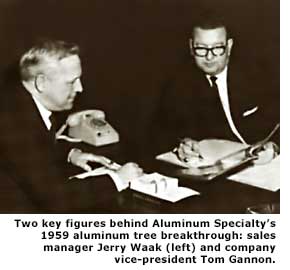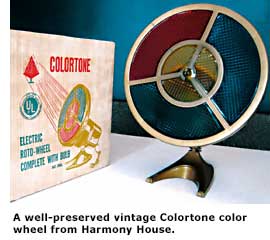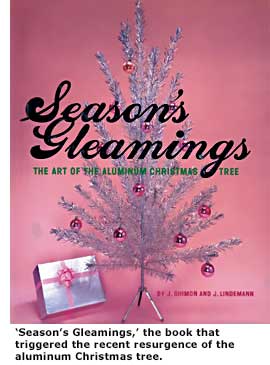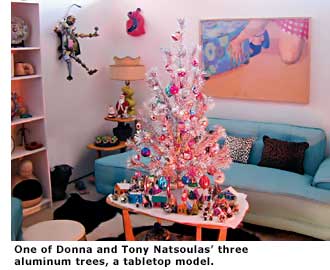Shimmering Nostalgia: The Aluminum Christmas Tree - Page 3

Waak offers a more prosaic explanation. The fad had run its course. "When we first brought the tree out, we said if we had it three years, that would be good," he says. "It lasted ten to 12 years."
By the early 1970s, aluminum orchards were uprooted all across our great land. It was a new era, the back-to-the-earth, natural-is-beautiful movement. Earth Day was born. Aluminum trees were trashed (recycling had yet to make much of an impact, alas), or hidden in closets or attics.
Then, oh so gradually, some made their way to thrift stores and antique emporiums where they caught the attention of society's more advanced thinkers, including artists Tony and Donna Natsoulas, who share a Streng tract home in Sacramento.
The couple found their first aluminum tree at an antique shop, and today owns three, including a vintage Penet-Ray. "I have a fondness for them," Donna says, "because my grandmother, who had streamline furniture and lived in a little ranch home in the Bay Area, had one. Call me sentimental."

"They fit the colorful outrageousness of our house," says Tony, who creates brightly painted, cartoon-like ceramic sculptures. "If we had a regular tree, it would be traditional, and we're definitely not traditional in our house."
"The trees fit the Streng house well. It's got that '50s, '60s look, like our house—instant Christmas. Everything was more instant in the '60s," he says.
Tony and Donna paid all of $35 for their first vintage tree in 1993. Today, vintage trees regularly sell for several hundred dollars. Rare trees—often the pink ones, which were the least popular back in the day—can command several thousand. And aluminum trees and color wheels are back in production, widely available and shimmering as ever.
In Manitowoc, where aluminum trees never completely disappeared (though Aluminum Specialty has long since shuttered its business), they are now omnipresent during the Christmas season, Kapler says.

Manitowoc may have the biggest bragging rights, but it is not the only metropolis capitalizing on the retro appeal of aluminum trees. Brevard, North Carolina got in on it too, thanks to Stephen Jackson, who founded ATOM (the Aluminum Tree and Ornament Museum) there in the mid-1990s. "It started out as a bad joke," he confessed to a reporter from Milwaukee. The museum, which at one point attracted 5,000 people a year, has closed it doors—at least for the moment.
It's true that some fans enjoy smirking at their aluminum trees—or, at least, leavening their love with irony. But scratch the surface and you're likely to discover something deeper.
"It's funny," Kapler says. "Forty years later, for some people these vintage trees—not the new aluminum trees today, but the vintage ones—reflect a warm and fuzzy feeling of holiday times, a nostalgic feeling about the holiday season."
"I was brought up in the '70s," Tony Natsoulas says, "and they hearken back to the '70s disco era. It's tinfoil, and a glitzy look. It's nostalgic to me because it feels like the disco era."
"I just think they're beautiful, that's all," he says.
Jerry Waak still loves the trees even though he no longer sells them, and believes that aluminum trees truly can evoke the holiday spirit. "A Christmas tree can be really anything," he says. "Nothing says it has to be green, or it has to be a certain shape or a certain size. Christmas is something that gets people's attention and dazzles them."

Modern decorating for modern trees

Modern design may be all about less-is-more—but Christmas decorating certainly is not. Just like their evergreen ancestors, aluminum trees cry out for ornaments and a proper setting.
"The key to the whole thing is having that rotating light," says Dave Peterson, who enjoys his mid-century Christmases in a San Jose Eichler.
"Oh, and the color wheels!" Donna Natsoulas exclaims. "Never have enough color wheels!"
The colored lights explain why silver trees are best, says Gary Gand, who owns two mid-century modern homes. Nothing reflects colors like pure silver.
Strings of electric lights are inadvisable for aluminum trees because they can cause a short—or worse.




